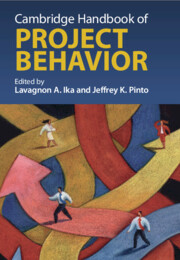Book contents
- Cambridge Handbook of Project Behavior
- Cambridge Handbook of Project Behavior
- Copyright page
- Contents
- Figures
- Tables
- Contributors
- Introduction
- Part I Guiding Principles
- Part II Deviating from Plans
- Chapter 6 Averaging Out Divergent Project Behavior
- Chapter 7 Intra- and Inter-Organizational Governance and the Behavior of Projects
- Chapter 8 Strategic Alignment, Uncertainties, and Realignment of Project Portfolios
- Chapter 9 Stakeholder Perceptions and Project Performance
- Chapter 10 Governance Shifts and Short-term Performance
- Chapter 11 Maximum Feasible Project Failure
- Chapter 12 Project Misbehavior in Infrastructure Projects
- Part III Practical Tips
- Index
- References
Chapter 11 - Maximum Feasible Project Failure
The German Reform of Money Laundering Prevention
from Part II - Deviating from Plans
Published online by Cambridge University Press: 22 November 2025
- Cambridge Handbook of Project Behavior
- Cambridge Handbook of Project Behavior
- Copyright page
- Contents
- Figures
- Tables
- Contributors
- Introduction
- Part I Guiding Principles
- Part II Deviating from Plans
- Chapter 6 Averaging Out Divergent Project Behavior
- Chapter 7 Intra- and Inter-Organizational Governance and the Behavior of Projects
- Chapter 8 Strategic Alignment, Uncertainties, and Realignment of Project Portfolios
- Chapter 9 Stakeholder Perceptions and Project Performance
- Chapter 10 Governance Shifts and Short-term Performance
- Chapter 11 Maximum Feasible Project Failure
- Chapter 12 Project Misbehavior in Infrastructure Projects
- Part III Practical Tips
- Index
- References
Summary
Projects whose very nature requires the involvement of government experts while simultaneously engaging politicians also involve higher risks of self-inflicted vulnerability. When self-management remains insufficient and boundary spanning across multiple jurisdictions is weak or absent, the influence of political actors, who inevitably lack ‘system knowledge’ and can ‘afford not to learn’, can easily be counterproductive. This is what the case of the German Reform of money laundering prevention of 2017 illustrates. What was intended as an improvement of law enforcement resulted in administrative disaster with the consequence of tens of thousands of cases of suspected money-laundering remaining unprocessed among which thousands of cases of financing terrorism. The case analysis underlines the relevance of a common understanding of a project’s mission among the stakeholders plus a communication strategy that stimulates the spirit of a common cause. Achieving stakeholder consensus in public sector projects is particularly challenging, however, due to the potential incompatibility between the rationale of politicians seeking to secure constituency support and that of experts striving to maintain their professional identity and standing. Which implies that one fundamental challenge of public sector project management is that the will of political actors to disregard existing expert knowledge is as unpredictable as their ability to get away with it through skillful communication.
Information
- Type
- Chapter
- Information
- Cambridge Handbook of Project Behavior , pp. 169 - 180Publisher: Cambridge University PressPrint publication year: 2025
References
Accessibility standard: WCAG 2.0 A
Why this information is here
This section outlines the accessibility features of this content - including support for screen readers, full keyboard navigation and high-contrast display options. This may not be relevant for you.Accessibility Information
Content Navigation
Allows you to navigate directly to chapters, sections, or non‐text items through a linked table of contents, reducing the need for extensive scrolling.
Provides an interactive index, letting you go straight to where a term or subject appears in the text without manual searching.
Reading Order & Textual Equivalents
You will encounter all content (including footnotes, captions, etc.) in a clear, sequential flow, making it easier to follow with assistive tools like screen readers.
You get concise descriptions (for images, charts, or media clips), ensuring you do not miss crucial information when visual or audio elements are not accessible.
You get more than just short alt text: you have comprehensive text equivalents, transcripts, captions, or audio descriptions for substantial non‐text content, which is especially helpful for complex visuals or multimedia.
You can access graphs or charts in a text or tabular format, so you are not excluded if you cannot process visual displays.
Visual Accessibility
You will still understand key ideas or prompts without relying solely on colour, which is especially helpful if you have colour vision deficiencies.
You benefit from high‐contrast text, which improves legibility if you have low vision or if you are reading in less‐than‐ideal lighting conditions.
